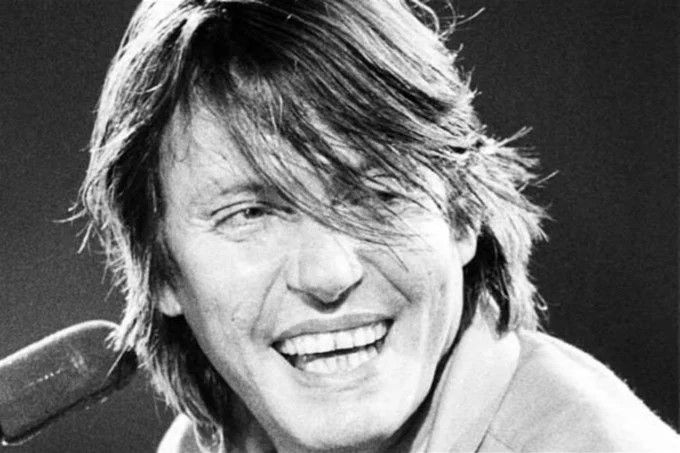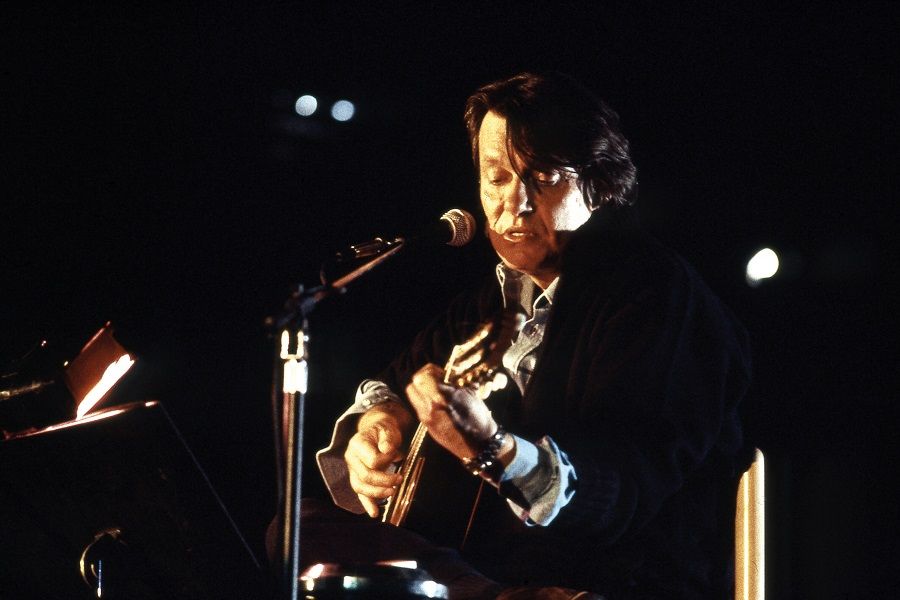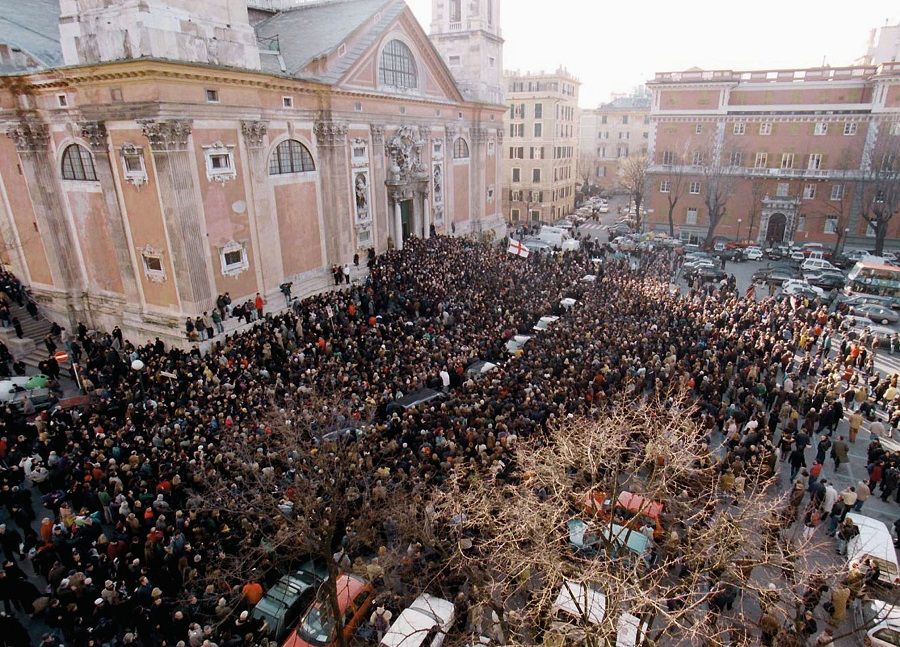Fabrizio De André: The Voice of Genoa

Fabrizio De André is Genoa, or Genoa is Fabrizio De André. His voice seems carved into the stones of the alleys of Genoa, telling us about Liguria. The remembrance, 25 years after his death.
Fabrizio De André was born in Genoa on February 18th, 1940, and passed away in Milan on January 11, 1999. Can a singer-songwriter represent a territory? Is there a city that sounds like a song? But is a singer-songwriter a poet? If it makes sense to ask these questions, the life and work of Fabrizio De André are the answer. With about forty years of career, fourteen albums plus singles and various anthologies, writing songs and melodies that have entered the hearts of all, Fabrizio De André – Faber – to friends, has a rightful place in the Italian literary tradition. The extreme care he has always dedicated to the lyrics and the accuracy of the rhymes and chords make him one of the greatest poets of the Italian ‘900.
Speaking about Fabrizio De André for us is like talking about Liguria: we would risk never finishing the topic, consuming all the battery of your phone. So we decided to focus on a few key concepts taken from his songs, leaving you the pleasure of delving into his knowledge yourself through his music.
The Biography
Fabrizio De André was born in the Genoese district of Pegli, at Via De Nicolay 12, to Giuseppe De André, CEO and president of the sugar factories Eridania, and Luigia (Luisa) Amerio, from an affluent family of wine producers. His formative years in Genoa were during the post-World War II era, where he met people who would remain friends for life, such as Paolo Villaggio, with whom he also wrote some songs. After completing high school and enrolling in law school at his father’s insistence, he abandoned his studies to pursue diverse activities and dedicate himself to music.
In 1960, he wrote his first song, “La ballata del Miché,” influenced by French singer-songwriters, and in 1961, he released his first 45 RPM record. The breakthrough came in 1964 with “La canzone di Marinella,” and three years later, Mina’s interpretation further fueled its success. From then on, his illustrious career took off with albums of great quality, from “Tutti morimmo a stento” (1968) to “La buona novella” (1970), inspired by the apocryphal Gospels, and “Non al denaro non all’amore né al cielo” (1971), based on Edgar Lee Masters’ “Spoon River Anthology.” In 1973, he released the politically charged concept album “Storia di un impiegato,” followed by “Canzoni” in 1974, “Volume 8” in 1975 (one of his most folk-oriented albums, co-written with Francesco De Gregori), and “Rimini” in 1978, where he approached American folk and pop. In 1979, De André became the subject of a notorious event that left a mark on his life and thinking: the kidnapping with his partner Dori Ghezzi in Sardinia. They were released after four months upon payment of a ransom. In 1981, he released “L’indiano,” focusing on a parallel between Native Americans and the Sardinian people. His last albums, “Creuza de mä” (1984), “Le nuvole” (1990), and “Anime salve” (1996), revolutionised the genre of singer-songwriter and Italian music, leaving behind a significant legacy still deeply referred to today.
Fabrizio De André received numerous awards and recognitions, including six Targhe, a Premio Tenco, and the Premio Lunezia in 1997. Alongside Bruno Lauzi, Gino Paoli, Umberto Bindi, and Luigi Tenco, he is considered one of the representatives of the Genoese school, a group of artists that profoundly renewed Italian light music. Fabrizio De André passed away on January 11, 1999, at the National Cancer Institute in Milan.

‘Creuza de mä’
If there is an anthem of Ligurian identity, perhaps it is “Creuza de mä” by Fabrizio De André. Right from the start, with the intense solo of the Macedonian bagpipe (a type of bagpipe), every Ligurian person subtly shows on their face the closest thing to a proud smile; a Genoese, if not already, probably sheds tears, crying like a child at the exact moment when “Umbre de muri muri de mainé/dunde ne vegnì duve l’è ch’ané” begins. This song truly encapsulates all of Liguria, its past, present, and future: a bustling seaport full of people coming and going; the work, the toil of the seafaring people; the grumbling, the resilience in the face of adversity, the closeness among a few familiar faces that taste of goodness; the ill-fortune drowned in wine and in the cuisine of a tavern. And a destiny to rewrite every day, traversing a “Creuza de mä,” a steep seaside path.
In the neighborhoods where the sun of the good God does not give its rays
Genoa and its narrow alleys, the famous “caruggi.” No one, like Fabrizio De André, has been able to describe its vibrant life, colours, flavours, and contradictions. As soon as you take a stroll through Genoa, you’ll immediately realise that next to the frescoed ceilings and magnificent facades of the sumptuous Palazzi dei Rolli – a UNESCO World Heritage site – often just across the street or a few meters away, there’s a whole other Genoa made up of the less fortunate, immigrants, and prostitutes. It’s a dim world where lives are led that are no less noble and worthy of being told, as De André sang in his songs. There’s no boundary between the two worlds; in Genoa, they coexist perfectly, with a continuous overflow between them: old professors, alcoholic retirees, dockworkers, merchants, laborers, thieves, judges, bank directors, and bourgeoisie. The secret of the alleys is not to judge anyone but to consider everyone as children and victims of this world.

‘Il suonatore Jones’
In this character taken from the album “Non al denaro, non all’amore né al cielo” from 1971 (inspired by Edgar Lee Masters’ Spoon River Anthology), there’s the inheritance, destiny, and condemnation of a great musician: if you know how to play, and people know you’re good, you’ll have to do it for the rest of your life. De André was well aware of the task life had assigned him, and he honoured it by creating some of the most beautiful melodies in Italian and international music. From the poignant “Canzone di Marinella” to the lively rhythm of “Bocca di rosa,” to the Genoese tongue-twister “Dolcenera” and the Neapolitan “Don Raffaè.” Starting with the style of the great French chansonniers, Fabrizio De André developed a vocal imprint and a poetic style of his own. He managed to blend the sounds of the Mediterranean, with unique attention to the Genoese dialect and other local idioms, collaborating with great musicians such as Mauro Pagani, Ivano Fossati, Massimo Bubola, and Nicola Piovani. The album “Creuza de mä” from 1984, entirely in Genoese, is considered a cornerstone of world music and ethnic music for its use and fusion of instruments, vocals, words, and sounds from the entire Mediterranean region.
‘As much as you may believe yourselves acquitted, you are forever involved’
Libertarian, anti-militarist, pacifist. In Fabrizio De André’s music, you will find the voice of someone who always moves “in a stubborn and contrary direction” and refuses to align with the status quo to avoid participating in the masked dance of modernity. He consistently stands on the side of the weakest, whether they are drunkards, thieves, or prostitutes from the alleys, Native Americans, rage-filled employees, or students of the French May ’68. If “Canzone del Maggio” is a tribute to the events of 1968, “La guerra di Piero” is a denunciation of the absurdity of any conflict that pits two equal men against each other. “Testamento di Tito” and “Il Blasfemo” take a stand against a church that doesn’t listen to the marginalized, while “Don Raffaé” openly addresses the issue of the mafia and the Camorra.
‘Sleep buried in a field of wheat’
At the funeral of Fabrizio De André, held at the Basilica of Santa Maria Assunta in Carignano, Genoa, on January 13, 1999, more than ten thousand people participated, making it one of the most memorable events in the minds of the people of Genoa. De André’s ashes were scattered in the Ligurian Sea, but his name is also inscribed on the family tomb at the Monumental Cemetery of Staglieno, next to his mother, father, and brother.
If you want to learn more about Fabrizio De André, explore stories, listen to his songs, and see his memorabilia, you can visit the museum dedicated to him and the Genoese school of singer-songwriters in Genoa.




